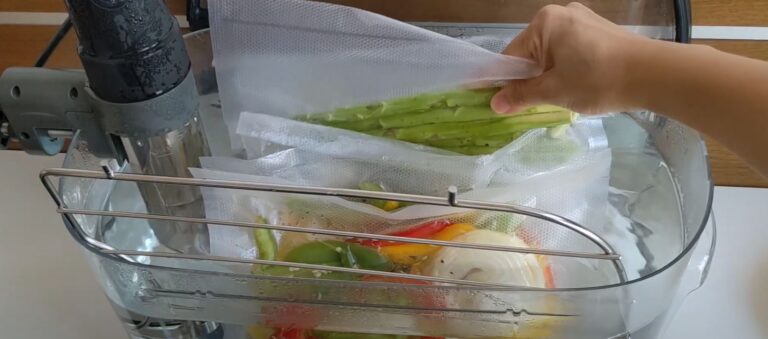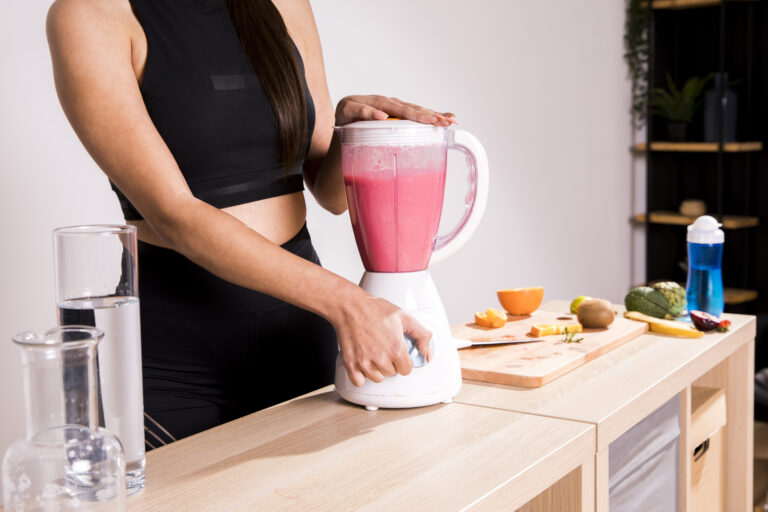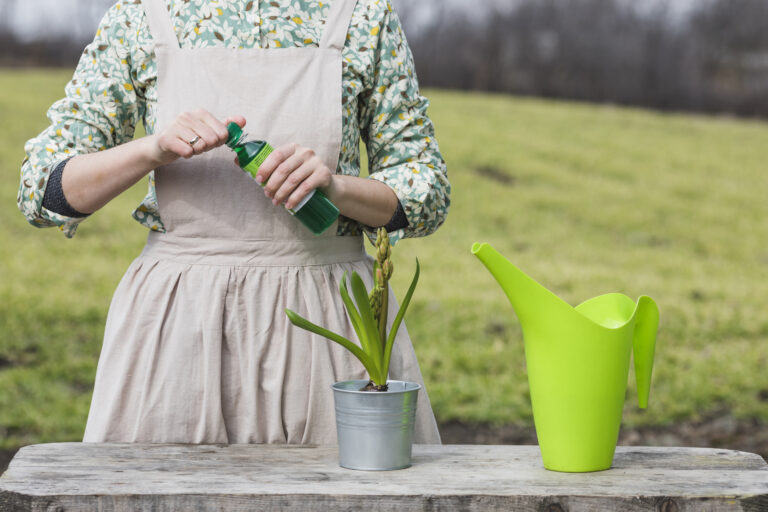DIY Misting System vs Automatic Watering System – Which One Fits Your Garden?
Over the years, I’ve experimented with a variety of garden setups from raised beds in my backyard to a small greenhouse in the corner of my property.
If there’s one lesson I’ve learned the hard way, it’s this: efficient watering and temperature control can make or break your garden especially in the sweltering U.S. summer heat.
I’ve used both traditional irrigation setups and more modern misting or cooling systems.
Each has its strengths. But figuring out which one fits your needs best depends on your climate, your plants, and your time.
Looking for a smarter way to keep your garden thriving through summer?
Let’s compare two of the most popular solutions available today based on performance, ease of setup, and long-term results.
What Is a DIY Misting System?
A DIY misting system is a simple setup that cools outdoor areas or gently hydrates plants using a fine spray of water.
It works through evaporative cooling when water mist evaporates in the air, it lowers the surrounding temperature. That makes it great not just for plants, but for people too.
Most systems use PVC pipe or flexible tubing, fitted with brass or stainless-steel misting nozzles, and connect easily to a standard garden hose. You can mount them along eaves, greenhouse frames, fences, or pergolas.
These systems are ideal for greenhouses, patios, balconies, and outdoor seating areas where you want cooler air and lighter watering without over-soaking the soil.
Pros of a DIY Misting System:
| Pros | Details |
|---|---|
| Affordable and customizable | Use common parts from hardware stores; build to fit any space |
| Great for cooling | Lowers temps by 10–20°F in dry climates |
| Gentle hydration for plants | Especially helpful for seed trays or humidity-loving vegetables |
| Easy to install | Most setups take less than an hour with basic tools |
Why This 82FT Misting Cooling System Became My Backyard Game-Changer
Last July, my patio felt unbearable by midday. I needed a low-cost, low-effort way to cool the space. After some research, I tried this 82FT misting system with 30 brass nozzles. It changed everything.
Setup was simple. The brass adapter fit my hose perfectly, and the tubing felt durable but flexible. I ran it along my fence and pergola, and had it working within 15 minutes no tools, no stress.
As soon as I turned on the water, a gentle mist started to cool the entire space. It made the air feel at least 15 degrees cooler within minutes.
The mist didn’t soak anything, just softened the heat enough to finally enjoy the outdoors.
I also used it near my greenhouse and dog’s play area. It worked great in both places. No leaking. No clogging. The brass nozzles spread the mist evenly and didn’t rust or corrode. It felt like a quality setup built to last.
The best part? It runs with zero electricity. Just your garden hose and water pressure. This made it perfect for my eco-conscious setup.
If your summers are sweltering and you want something affordable that actually works, I highly recommend this system. Feel free to reach out I’ll happily share installation tips or nozzle layouts that worked for me.

| Pros | Cons |
|---|---|
| Drops temp quickly—up to 20°F | Needs nearby hose access |
| Installs in 10–15 minutes | Occasional nozzle cleaning recommended |
| Strong brass nozzles, no leaks | Tubing may fade slightly in full sun over time |
| No electricity required | Not ideal for permanent commercial setups |
| Excellent for patios, greenhouses, pets | May require extra clamps in complex layouts |
Why I Recommend the Bonviee 75FT Patio Misting System for Summer Relief
I installed the Bonviee misting system a few weeks ago, and I genuinely love the results. My patio felt unbearable in the afternoon heat, but this kit made a huge difference.
The setup was incredibly simple. It came pre-assembled, which saved me time. I just connected the metal adapter to my outdoor faucet, tied down the tubing, and it was good to go.
The mist feels light but powerful. Within minutes, it cooled my patio noticeably. I checked with a thermometer—my sitting area dropped almost 15 degrees. That fine mist really works, especially around seating and the garden.
The brass nozzles sprayed evenly without dripping or clogging. I liked how secure the tubing and connectors felt. No leaks. No pressure loss. It looked clean and professional once installed.
I also appreciate the length. At 75 feet with 28 nozzles, I had plenty of coverage for my patio and even routed a line toward the greenhouse. It made our cookouts and gardening afternoons so much more enjoyable.
If you’re like me and want a fast way to beat the summer heat, I highly recommend this. It’s a budget-friendly solution that performs like a premium setup.
Feel free to message me if you’re planning your layout—I’d be happy to help!
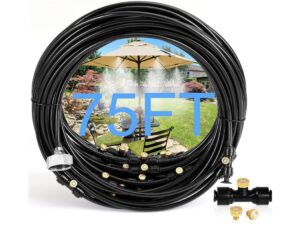
| Pros | Cons |
|---|---|
| Reduces temperature quickly | Needs nearby faucet access |
| Brass nozzles spray clean and evenly | Tubing might need extra clips in windy areas |
| Long 75FT length fits large patios | Not compatible with all hose types |
| Easy, no-tool installation | May require draining after use in colder zones |
| Durable UV-resistant tubing and metal adapter | Mist can drift slightly in breezy conditions |
Beat the Summer Heat with homenote Misting System: My Honest Experience
I set up the homenote misting system in my backyard last week, and it surprised me with how fast it changed the comfort level outside.
The pre-assembled kit made installation a breeze. I had it running in under 10 minutes.
Once turned on, the mist felt light, even, and cool. It dropped the temperature on my patio from scorching to comfortable in minutes.
I placed it along the edge of my canopy and it covered the space perfectly.
The brass nozzles do a great job. They don’t drip or leak. I ran the system daily for long hours and haven’t faced any clogs or pressure issues.
The PU tubing feels durable and doesn’t kink like cheaper versions I’ve used before.
What stood out to me most was how little water it used. Despite running for hours, I didn’t see any spike in my water bill.
It runs without electricity, so there’s no ongoing cost just connect to your faucet and go.
I also installed a few lines near the greenhouse. The plants love the humidity. It’s gentle enough for delicate leaves yet strong enough to cool down the space around them.
If you’re looking for a simple and effective way to stay cool outdoors or water plants in a fine mist, I fully recommend this system.
Feel free to reach out if you need help with layout ideas or setup.
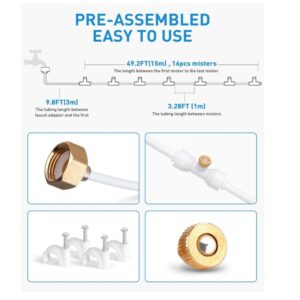
| Pros | Cons |
|---|---|
| Easy, tool-free setup | Not ideal in windy locations |
| Fine mist cools air quickly | May need extra clips for tight routing |
| Durable brass nozzles, no leaks or rust | Needs faucet access |
| No electricity required | Cannot control pressure individually |
| Ideal for patios, greenhouses, playsets | Tubing may fade with long sun exposure |
What Is an Automatic Watering System?
An automatic watering system delivers water directly to the soil using drip irrigation lines, sprinklers, or soaker hoses, all managed by a timer or smart controller.
These systems are designed for efficient, targeted watering, and are great for busy gardeners.
Depending on the size and layout of your garden, you might choose drip emitters for containers, sprinklers for open beds, or even moisture sensors that trigger watering only when needed.
This setup is ideal for raised beds, container gardens, vegetable rows, and larger landscapes where consistent, deep watering is important.
Automatic Watering System:
| Pros | Details |
|---|---|
| Set it and forget it | Fully programmable via timers or phone apps |
| Conserves water | Drip systems use 30–50% less water than manual watering |
| Encourages healthy root development | Water goes directly to the base of the plants |
| Smart home compatible | Some controllers work with Alexa, Google, or app-based scheduling |
MIXC Drip Irrigation Kit Review: A Backyard Time-Saver That Delivers
I installed the MIXC drip irrigation kit a few weekends ago, and I instantly felt the difference in both time saved and plant health.
The setup was simple. I didn’t need to dig or run plumbing. Just followed the guide and had everything in place within an hour.
What impressed me first was the spray visibility. The mist pattern from the nozzles was easy to control and surprisingly accurate. I liked how bright and defined the water streams looked across my patio beds and greenhouse corners.
The fit of this system is what makes it worth every penny. It includes over 100 feet of tubing and adjustable nozzles that let you control each plant’s water level. I have potted flowers, herbs, and a few tomato plants all thriving now.
The 4×6-way connector is smart. It splits the pressure evenly without needing a booster pump. Even the farthest sprayers work just as well as the ones closer to the faucet.
No more standing around with a hose or worrying about missing a watering day. This setup gives me more time to enjoy my garden, not just work in it. I recommend it for anyone with a busy schedule or inconsistent weather.
If you want to upgrade your watering setup, this kit makes the jump easy. Ask me questions or share how you’re using yours I’d love to hear.
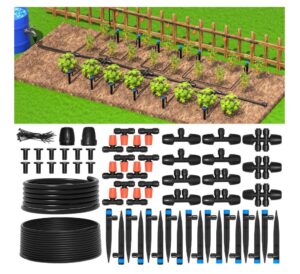
| Pros | Cons |
|---|---|
| Covers up to 160 sq. ft | Tubing may kink if not straightened |
| Adjustable nozzles for full control | Needs regular flushing to avoid clogs |
| No tools or digging required | Not ideal for very large yards |
| Distributes water evenly | Requires faucet connection |
| Great for greenhouse and patio use | Barbed fittings take some hand strength |
CARPATHEN Drip Irrigation Kit Review: A Garden Essential That Works With You
I’ve set up a few irrigation systems over the years, but the CARPATHEN kit stood out. From unboxing to installation, everything felt simple and well thought out.
You don’t need special tools or plumbing skills—just follow the included guide.
I appreciated how flexible the tubing was. The 5/16-inch mainline and 1/4-inch branches gave me full control to route water to each raised bed.
I used the vortex emitters for my tomato rows and the spray emitters around leafy greens. The water delivery looked clean and steady exactly what I needed.
Brightness-wise, I could instantly see the emitters in action. No second guessing if they were working.
The pressure held up well even when I ran 30 emitters at once. This setup runs quietly in the background while I take care of other things.
It fits my small raised garden layout perfectly. I covered three beds and still had tubing left over. The stakes dig easily into the soil and don’t shift. I liked that the heads unscrew for cleaning. I haven’t had one clog yet.
If you’re tired of overwatering or dragging hoses around, this is the upgrade to make. It saves time, water, and lets you enjoy your garden again. I’d love to hear how you’re setting up yours. Let’s compare layouts.
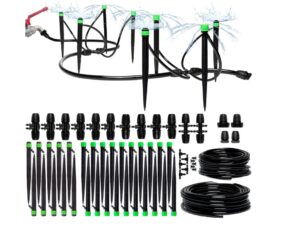
| Pros | Cons |
|---|---|
| Covers up to 3 raised beds | Takes time to plan layout |
| Adjustable emitters for precise watering | Requires moderate hand strength |
| Tubing is UV-resistant and flexible | Not ideal for very large landscapes |
| Easy to install with no digging | No timer included |
| Clear water flow and strong pressure control | Some fittings may need extra force |
Which One Should You Choose?
Choosing between a misting system and an automatic watering system depends on your climate, garden size, and the plants you grow.
If you live in a hot, dry region and want to cool down a patio or greenhouse while lightly watering surface-level plants like herbs or seedlings, a DIY misting system is a great fit.
It’s also perfect if you’re on a tight budget or need something quick and easy to install.
On the other hand, if your garden includes vegetable beds, deep-rooted plants, or container gardens, an automatic watering system will be more effective.
It provides deep, consistent hydration, especially for larger landscapes or people who travel often.
Also consider maintenance: Misting systems are lower cost but can clog over time.
Drip systems may cost more up front but offer better long-term control and are highly efficient with water.
Personal Recommendation:
-
Use misting systems for patios, small greenhouses, or tropical plants that love humidity.
-
Choose automatic watering systems for veggie gardens, flower beds, and larger outdoor spaces that need reliable deep watering.
Tips for Maximizing Performance
To get the best results from either system, follow these expert tips:
-
Automate your misting setup: Pair misting lines with a simple outdoor timer. This saves water and gives you consistent cooling and hydration without the hassle of manual operation.
-
Use filters to prevent clogging: Whether you’re using misting nozzles or drip emitters, a water filter helps reduce buildup from minerals or debris especially if you’re in a hard water area.
-
Monitor soil moisture: Add a moisture sensor to your drip irrigation setup to avoid overwatering. These are especially helpful in clay-heavy soils or raised beds.
-
Seasonal care matters: Clean and flush your irrigation lines before winter and store misting nozzles indoors if temps drop. This keeps everything working year after year.
Frequently Asked Questions: Misting Systems vs. Automatic Watering Systems
1. How do you make a misting system at home?
To make a DIY misting system, you’ll need flexible tubing (like 1/4 or 3/8 inch), misting nozzles (preferably brass), barbed connectors, and a standard garden hose adapter. Connect the tubing to your faucet using the adapter, attach nozzles at intervals, and secure it with zip ties along fences, pergolas, or greenhouse frames. You can add a timer for automatic operation.
2. Do misting systems really work?
Yes, misting systems are highly effective for cooling outdoor spaces like patios and greenhouses. They work through evaporative cooling—fine mist evaporates quickly, lowering ambient temperatures by up to 20°F (6–10°C). They also help maintain humidity around plants during dry or hot seasons.
3. What is the difference between a fogging system and a misting system?
Misting systems release slightly larger water droplets than foggers. Fogging systems use high pressure (above 1000 PSI) to create an ultra-fine fog, ideal for cooling without wetting surfaces. Misting systems use lower pressure (usually 40–150 PSI) and produce a visible mist. Fogging is better for rapid cooling in large areas or animal enclosures, while misting suits patios, plants, and home gardens.
4. What are the disadvantages of misting systems?
-
Can cause over-humidity in enclosed spaces
-
Nozzles may clog without water filters
-
Not suitable for deep watering
-
Manual systems require regular operation unless automated
Misting works best when paired with a timer and used in open or semi-open environments.
5. Is there an automatic watering system?
Yes. Automatic watering systems include drip irrigation kits, sprinkler systems, and smart controllers. These systems deliver water directly to plant roots using pre-set schedules, moisture sensors, or weather data, reducing water waste and saving time.
6. What are the disadvantages of an automatic watering system?
-
Higher upfront cost compared to manual watering
-
Requires planning and setup
-
Needs occasional maintenance (clog cleaning, emitter replacement)
-
Can overwater if sensors or timers are not calibrated correctly
Despite the drawbacks, many gardeners find them efficient and stress-reducing.
7. Are automatic plant waterers worth it?
Yes, especially for busy gardeners, frequent travelers, or people managing multiple beds or potted plants. They ensure consistent watering, improve plant health, and reduce water usage. Over time, they can also lower your water bill and labor costs.
8. How do you make a self-watering system at home?
To create a simple DIY self-watering system:
-
Use a plastic bottle with a pinhole or cotton wick system
-
Insert the bottle upside down into the soil near the roots
-
Or use capillary action with a water reservoir under potted plants and a wick connecting the soil
For more advanced setups, use gravity-fed irrigation from elevated tanks connected to tubing and drippers.
Conclusion
Both misting systems and automatic watering systems play important roles in keeping your garden healthy and vibrant but they serve different purposes.
-
Go with a misting system for surface-level hydration and climate cooling, especially in greenhouses or outdoor lounging areas.
-
Choose an automatic watering system if you need deep, hands-free watering that keeps plants thriving without daily attention.
No matter what you choose, the key is to match the system to your garden’s size, climate, and plant types.
Ready to upgrade your setup? Explore the top-rated misting kits and watering systems on Amazon to find the one that’s right for your space.


